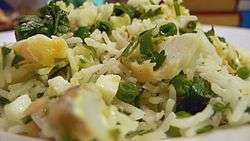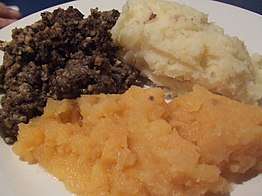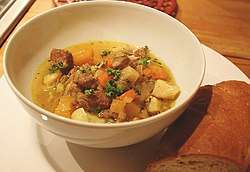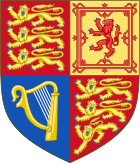British cuisine
British cuisine is the heritage of cooking traditions and practices associated with the United Kingdom. Although Britain has a rich indigenous culinary tradition, its colonial history has profoundly enriched its native cooking traditions. British cuisine absorbed the cultural influences of its post-colonial territories – in particular those of South Asia.[1][2]
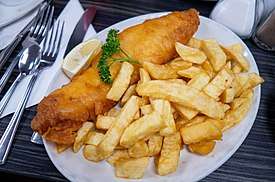

In ancient times Celtic agriculture and animal breeding produced a wide variety of foodstuffs for the indigenous Celts and Britons. Anglo-Saxon England developed meat and savoury herb stewing techniques before the practice became common in Europe. The Norman conquest introduced exotic spices into England in the Middle Ages.[3] The British Empire facilitated a knowledge of Indian cuisine with its "strong, penetrating spices and herbs".[3] Food rationing policies put into place by the British government during the wartime periods of the 20th century[4] are widely considered today to be responsible for British cuisine's poor international reputation.[3]
Well-known traditional British dishes include full breakfast, fish and chips, the Christmas dinner,[3] the Sunday roast, steak and kidney pie, shepherd's pie, and bangers and mash. People in Britain, however, eat a wide variety of foods based on the cuisines of Europe, India, and other parts of the world. British cuisine has many regional varieties within the broader categories of English, Scottish and Welsh cuisine and Northern Irish cuisine. Each has developed its own regional or local dishes, many of which are geographically indicated foods such as Cornish pasties, the Yorkshire pudding, Cumberland Sausage, Arbroath Smokie, and Welsh cakes.
History
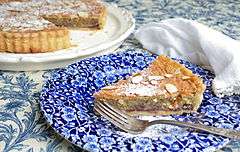
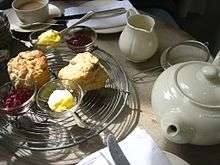
Romano-British agriculture, highly fertile soils and advanced animal breeding produced a wide variety of very high quality foods for indigenous Romano-British people. Anglo-Saxon England developed meat and savoury herb stewing techniques and the Norman conquest reintroduced exotic spices and continental influences back into Great Britain in the Middle Ages[3] as maritime Britain became a major player in the transcontinental spice trade for many centuries after. Following the Protestant Reformation in the 16th and 17th centuries "plain and robust" food remained the mainstay of the British diet, reflecting tastes which are still shared with neighbouring north European countries and traditional North American Cuisine. In the 18th and 19th centuries, as the Colonial British Empire began to be influenced by India's elaborate food tradition of "strong, penetrating spices and herbs". The United Kingdom developed a worldwide reputation[5] for the quality of British beef and pedigree bulls were exported to form the bloodline of major modern beef herds in the New World.[3] Developments in plant breeding produced a multiplicity of fruit and vegetable varieties, with British disease-resistant rootstocks still used globally for fruits such as apples.
During the World Wars of the 20th century difficulties of food supply were countered by official measures, which included rationing. The problem was worse in WWII, and the Ministry of Food was established to address the problems (see Rationing in the United Kingdom). Due to the economic problems following the war, rationing continued for some years, and in some aspects was more strict than during wartime. Rationing was not fully lifted until almost a decade after war ended in Europe, so that a whole generation was raised without access to many previously common ingredients. These policies, put in place by the British government during wartime periods of the 20th century,[4] are often blamed for the decline of British cuisine in the 20th century.
The last half of the 20th century saw an increase in the availability of a greater range of good quality fresh products and greater willingness by many sections of the British population to vary their diets and select dishes from other cultures such as those of Italy and India.
Efforts have been made to re-introduce pre-20th-century recipes. Ingredients not native to the islands, particularly herbs and spices, are frequently added to traditional dishes (echoing the highly spiced nature of much British food in the medieval era).
Much of Modern British cooking also draws heavily on influences from Mediterranean, and more recently, Middle Eastern, South Asian, East Asian and Southeast Asian cuisines. The traditional influence of northern and central European cuisines is significant but fading.
The mid-20th-century British style of cooking emerged as a response to the depressing food rationing that persisted for several years after the Second World War, along with restrictions on foreign currency exchange, making travel difficult. A hunger for exotic cooking was satisfied by writers such as Elizabeth David, who from 1950 produced evocative books, starting with A Book of Mediterranean Food, whose ingredients were then often impossible to find in Britain.[6] By the 1960s foreign holidays, and foreign-style restaurants in Britain, further widened the popularity of foreign cuisine. Recent modern British cuisine has been influenced and popularised by TV chefs, all also writing books, such as Fanny Cradock, Clement Freud, Robert Carrier, Keith Floyd, Gary Rhodes, Delia Smith, Gordon Ramsay, Ainsley Harriott, Nigella Lawson, Simon Hopkinson, Nigel Slater and Jamie Oliver, alongside The Food Programme, made by BBC Radio 4.
Christmas dinner
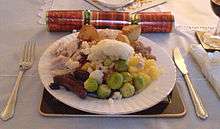
Since appearing in Christmas dinner tables in England in the late 16th century, the turkey has become more popular, with Christmas pudding served for dessert.[7][8] The 16th-century English navigator William Strickland is credited with introducing the turkey into England, and 16th-century farmer Thomas Tusser noted that in 1573 turkeys were eaten at Christmas dinner.[9] Roast turkey is often accompanied with roast beef or ham, and is served with stuffing, gravy, roast potatoes, mashed potatoes and vegetables. In addition to Christmas pudding, trifle, mince pies, Christmas cake or a yule log are also popular desserts.[10]
Varieties
Anglo-Indian cuisine
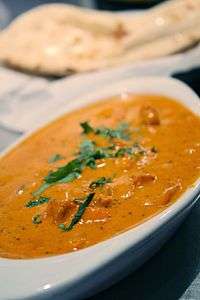
Some Anglo-Indian dishes derive from traditional British cuisine, such as roast beef, modified by the addition of Indian-style spices, such as cloves and red chillies. Fish and meat are often cooked in curry form with Indian vegetables. Anglo-Indian food often involves use of coconut, yogurt, and almonds. Roasts and curries, rice dishes, and breads all have a distinctive flavour.
Signs of curry's popularity in Britain slowly became evident by the later 1960s and 1970s, when some establishments that originally catered almost exclusively to Indians gradually observed a diversifying clientele.[12]
English cuisine
English cuisine encompasses the cooking styles, traditions and recipes associated with England. It has distinctive attributes of its own, but also shares much with wider British cuisine, partly through the importation of ingredients and ideas from North America, China, and India during the time of the British Empire and as a result of post-war immigration.[13]
Some traditional meals, such as bread and cheese, roasted and stewed meats, meat and game pies, boiled vegetables and broths, and freshwater and saltwater fish have ancient origins. The 14th-century English cookbook, the Forme of Cury, contains recipes for these, and dates from the royal court of Richard II.
Northern Irish cuisine
The cuisine of Northern Ireland is largely similar to that of the rest of the island of Ireland. In this region, the Ulster Fry is particularly popular.
Scottish cuisine
Scottish cuisine is the specific set of cooking traditions and practices associated with Scotland. It shares much with English cuisine, but has distinctive attributes and recipes of its own. Traditional Scottish dishes such as haggis and shortbread exist alongside international foodstuffs brought about by migration. Scotland is known for the high quality of its beef, lamb, potatoes, oats, and sea foods. In addition to foodstuffs, Scotland produces a variety of whiskies.
Welsh cuisine
Welsh cuisine has influenced, and been influenced by, other British cuisine. Although both beef and dairy cattle are raised widely, especially in Carmarthenshire and Pembrokeshire, Wales is best known for its sheep, and thus lamb is the meat traditionally associated with Welsh cooking.
Dates of introduction to Britain
Prehistory (before 43 AD)
Roman era (43 to 410)
Post-Roman period to the discovery of the New World (410 to 1492)
1492 to 1914
|
After 1914
- sugar beet: 1914–1918
- sliced bread: 1930[25]
See also
References
- "Robin Cook's chicken tikka masala speech". The Guardian. London. 25 February 2002. Retrieved 19 April 2001.
- BBC E-Cyclopedia (20 April 2001). "Chicken tikka masala: Spice and easy does it". bbc.co.uk. Retrieved 28 September 2007.
- Spencer, Colin (2003). British Food: An Extraordinary Thousand Years of History. Columbia University Press. ISBN 978-0-231-13110-0.
- Ina Zweiniger-Bargielowska Austerity in Britain: Rationing, Controls and Consumption, 1939–1955, Oxford UP (2002) ISBN 978-0-19-925102-5. For general background, see David Kynaston Austerity Britain, 1945–1951, Bloomsbury (2007) ISBN 978-0-7475-7985-4.
- "Great British Kitchen". Great British Kitchen. Retrieved 3 June 2010.
- Panayi, Panikos (2010) [2008]. Spicing Up Britain. Reaktion Books. pp. 191–195. ISBN 978-1-86189-658-2.
- Broomfield, Andrea (2007). "Food and cooking in Victorian England: a history". pp. 149–150. Greenwood Publishing Group, 2007
- John Harland (1858). The house and farm accounts of the Shuttleworths of Gawthorpe Hall in the county of Lancaster at Smithils and Gawthorpe: from September 1582 to October 1621. p. 1059. Chetham society,
- Emett, Charlie (2003) "Walking the Wolds". Cicerone Press Limited, 1993
- Muir, Frank (1977) Christmas customs & traditions p. 58. Taplinger Pub. Co., 1977
- "Robin Cook's chicken tikka masala speech". The Guardian. London. 25 February 2002. Retrieved 19 April 2001.
- Elizabeth Buettner. ""Going for an Indian": South Asian Restaurants and the Limits of Multiculturalism in Britain" (PDF). southalabama.edu. Retrieved 11 October 2015.
- Dickson Wright, Clarissa (2011) A History of English Food. London: Random House. ISBN 978-1-905-21185-2.
- ""Bread in Antiquity", Bakers' Federation website". Bakersfederation.org.uk. Archived from the original on 20 April 2010. Retrieved 3 June 2010.
- "Diet and Romano-British Society " Archaeozoology". Archaeozoo.wordpress.com. 28 November 2007. Retrieved 3 June 2010.
- "archive Unearthing the ancestral rabbit", British Archaeology, Issue 86, January/February 2006
- ""Cooking by country: England", recipes4us.co.uk, Feb 2005". Recipes4us.co.uk. Archived from the original on 7 June 2010. Retrieved 3 June 2010.
- Romano-British – food facts – History cookbook. Cookit!
- "Chives", Steenbergs Organic Pepper & Spice Archived 11 December 2007 at the Wayback Machine
- ""Coriander", The Best Possible Taste". Thebestpossibletaste.co.uk. Archived from the original on 13 December 2010. Retrieved 3 June 2010.
- Yardley, Michael (9 October 2015). "The history of the pheasant". The Field. Retrieved 19 October 2018.
- Hickman, Martin (30 October 2006). "The secret life of the sausage: A great British institution". The Independent. Retrieved 15 April 2015.
- "Grieve, M. "Mints", A Modern Herbal". Botanical.com. Retrieved 3 June 2010.
- Hovis Fact File (PDF) Archived 3 October 2008 at the Wayback Machine
- ""Food History Timeline", BBC/Open University". Web.archive.org. 18 November 2004. Archived from the original on 18 November 2004. Retrieved 3 June 2010.
- Lee, J.R. "Philippine Sugar and Environment", Trade Environment Database (TED) Case Studies, 1997
- "Stolarczyk, J. "Carrot History Part Two – A.D. 200 to date"". Web.archive.org. 3 March 2005. Archived from the original on 3 March 2005. Retrieved 3 June 2010.
- "Turkey Club UK". Turkeyclub.org.uk. Retrieved 3 June 2010.
- "DeWitt, D. 'Pepper Profile: Cayenne'". Fiery-foods.com. Archived from the original on 14 June 2008. Retrieved 3 June 2010.
- "Properties and Uses: Parsley", Herbs and Aromas Archived 9 December 2007 at the Wayback Machine
- "Fruits Lemon to Quince", The Foody UK & Ireland
- "Coleman, D. "horseradish", Herb & Spice Dictionary". Deancoleman.com. Archived from the original on 1 October 1999. Retrieved 3 June 2010.
- "Dunlop, F. "Tea", BBC Food". Bbc.co.uk. Retrieved 3 June 2010.
- Forbes, K.A. "Bermuda's Flora" Archived 3 April 2007 at the Wayback Machine
- ""Coffee in Europe", The Roast & Post Coffee Company". Realcoffee.co.uk. Retrieved 3 June 2010.
- The History of Ice Cream canalmuseum.org.uk.
- "Vitamin C – Broccoli, Brussels Sprouts", Your Produce Man, April 2005 "Archived copy". Archived from the original on 14 November 2007. Retrieved 28 November 2007.CS1 maint: archived copy as title (link)
- Cox, S. "I Say Tomayto, You Say Tomahto...", landscapeimagery.com, 2000
- "National Rhubarb Collection", RHS Online, 2006 Archived 8 June 2007 at the Wayback Machine
- "'Marmite'". Unilever.co.uk. Archived from the original on 30 September 2009. Retrieved 3 June 2010.
Further reading
- Addyman, Mary; Wood, Laura; Yiannitsaros, Christopher (eds). (2017) Food, Drink, and the Written Word in Britain, 1820–1945, Taylor & Francis.
- Brears, P. (2008) Cooking and Dining in Medieval England
- Burnett, John. (1979) Plenty and want: a social history of diet in England from 1815 to the present day, 2nd ed. A standard scholarly history.
- Burnett, John. (2016) England eats out: a social history of eating out in England from 1830 to the present, Routledge.
- Collingham, Lizzy (2018). The Hungry Empire: How Britain's Quest for Food Shaped the Modern World. Vintage. ISBN 978-0099586951.
- Collins, E. J. T. (1975) "Dietary change and cereal consumption in Britain in the nineteenth century." Agricultural History Review 23#2, 97–115.
- Green, Kate & Bryan, Melanie (2020) "Around Britain in 50 foods"; in: Country Life; February 12, 2020, pp. 36-41
- Harris, Bernard; Floud, Roderick; Hong, Sok Chul. (2015) "How many calories? Food availability in England and Wales in the eighteenth and nineteenth centuries". Research in economic history.. 111–191.
- Hartley, Dorothy. (2014) Food In England: A complete guide to the food that makes us who we are, Hachette UK.
- Meredith, David; Oxley, Deborah. (2014) "Nutrition and health, 1700–1870." in The Cambridge economic history of modern Britain. Vol. 1.
- Woolgar. C.N. (2016) The Culture of Food in England, 1200–1500.
Historiography
- Otter, Chris. "The British Nutrition Transition and its Histories", History Compass 10#11 (2012): pp. 812–825, doi:10.1111/hic3.12001
External links
| Wikibooks has a book on the topic of: Cookbook:Cuisine of the United Kingdom |
| Wikimedia Commons has media related to Cuisine of the United Kingdom. |
- Food Stories – Explore a century of revolutionary change in UK food culture on the British Library's Food Stories website
- George Orwell's essay "In Defence of English Cooking"

